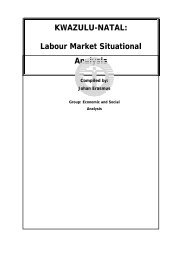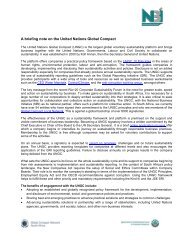Sustainable Forest Finance Toolkit - PwC
Sustainable Forest Finance Toolkit - PwC
Sustainable Forest Finance Toolkit - PwC
- No tags were found...
Create successful ePaper yourself
Turn your PDF publications into a flip-book with our unique Google optimized e-Paper software.
Russia – country briefing note 2 of 3New Application HOMENature of forests and timber movementsVast stretches of Russia are covered in forest, amounting toover one fifth of the world’s timber reserves.Russian forests are also ecologically important, making asubstantial contribution to the global carbon balance andhousing diverse ecosystems. The total forested area, withboreal forests predominating, is estimated at anywhere fromaround 760 million hectares to around 1,180 million hectares,with the UN’s Food and Agricultural Organization (UNECE-FAO) settling on 809 million hectares in its most recent study.The discrepancies are probably due to complexities in how theRussian government classifies forest lands.Country-specific sustainability issuesRussia’s forestry segment struggles with inadequateinfrastructure and the impact of an enormous illegal loggingindustry. The summer of 2006 also brought some additionalchallenges, as the number and severity of forest fires surgedthroughout Russia.Illegal logging is another serious challenge facing the industry inRussia. Reports on the scope of illegal logging vary widely.While in the past the Ministry of Natural Resources assertedthat illegal logging only accounted for 0.5% of total logging inRussia, in March 2006 Valeriy Roshchupkin, head of the FFA,estimated the volume of illegal logging in Russia at 10-15%.Other sources in the industry have estimated that up to 20% oftimber harvests might be classed as illegal, placing the level ofillegal logging at up to around 30 million m 3 at today’s rate ofcutting. In fact, some environmental groups believe that theactual rate of illegal logging is much higher. Regardless of theexact extent of illegal logging, it is clear that it is costly to theRussian economy and has a negative impact on the legitimatetrade in forest products, not least by keeping wood prices low,discouraging the development of value-added wood processingand consolidation in the logging sector.Illegal logging is very costly for both the government andindustry. Much-needed measures like additional aerial andspace monitoring and more railroad checkpoints are beingapplied to reduce illicit felling. The government is taking theissue seriously and has taken several steps to address it.Aerial and space monitoring technologies are now beingemployed in a number of regions with developed timberharvesting, and the FFA planned to expand the systems toinclude all harvested areas by 2007. In addition to spottingillegal loggers, the technology is intended to help monitorforest fires. In June 2006, official reports indicated that themonitoring system had identified around 1.2 million m 3 ofillegal logging. Clearly there is still a way to go to address theproblem fully.Regional authorities are also stepping up efforts to thwartillegal logging. The Siberian province of Irkutsk hasannounced plans to establish 10 new inspection points alongthe Trans-Siberian railway, one of the main transit routesfrom Russia to China.The Europe and North Asia <strong>Forest</strong> Law Enforcement andGovernance (ENA-FLEG) committee is leading the fightagainst illegal logging globally. Russia is a relative newcomerto ENA-FLEG, but is already looking to take a leading role inits activities. In November 2005, Russia hosted a MinisterialConference in St. Petersburg. Cooperation between ENA-FLEG members and strategies for eliminating illegal loggingand timber trading formed the focus of discussions. ENA-FLEG is looking to promote standard market regulation,forest management certification, and the marking of roundwood to help fight illegal logging. The organisation has alsoacknowledged that rural poverty in forest areas contributes toillegal logging in some regions, and stresses the need forreform of forest legislation, as well as enforcement of existinglegislation.More wide-reaching efforts to fight government corruptionshould have a positive effect. Shifting authority over forestresources from federal to regional authorities may pose newPage 66challenges, however, as it will necessitate transparentcooperation between the various ministries responsible foroverseeing the industry.Russia’s forests cover a vast area, and the logging industryis extremely fragmented. The predominance of smallplayers makes illegal logging more difficult to combat, asillegal cutters often strip a small area and move on beforesatellite monitoring or other techniques are able to detecttheir activities. Efforts to increase vertical integration in theindustry may therefore have a positive effect on the rate ofillegal logging, by decreasing the number of small players.OpportunitiesOn another note, Russia’s forest industry may benefit fromseveral global trends, which focus on generating morevalue from forest resources. The introduction of biomasstechnology can allow mills to produce products with highervalue added while minimising environment impact.Harvesting natural forest products such as resin or wildberries can also generate revenues without necessitatingextensive cuttings. Domestic demand for wood-based fuelsmay also increase in the short and medium term, reflectinga global trend towards increased use of renewable energysources. There are export opportunities too, for examplethrough converting sawmill waste into fuel pellets. Realisingthese opportunities, however, requires technology,surmounting logistical difficulties and capital.Generally speaking, across Russia as a whole, overalllogging rates in early 2009 are about 25% of annualallowable cut (AAC), meaning there could be potential toincrease this without compromising sustainable forestrypractices. The biggest challenges to increasing this inpractice are that the most economically feasible andphysically accessible forest resources are already undermanagement. Remote regions may offer future growthpotential. However, despite the low national rates,unsustainable and illegal logging practices are prevalent atlocal levels.pwc
















